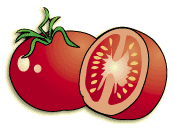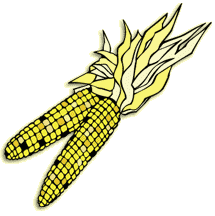Frequently Asked Questions on the Guidelines on Voluntary Labelling of Genetically Modified (GM) Food Please click here
Frequently Asked Questions in General
1. How long have GM foods been on the market?
 The application of modern biotechnology in food production was started in the 90s. The first GM whole food, FLAVR SAVRTM tomato, was marketed in the United States in 1994.
The application of modern biotechnology in food production was started in the 90s. The first GM whole food, FLAVR SAVRTM tomato, was marketed in the United States in 1994.
2. What are the most common GM food ingredients or food products in the market?
 The most common GM foods currently available in the market are soya bean and corn. Soya beans can be further processed into soy oil, soy flour to make food items such as pastries, edible oil and other soy products. Corn can be further processed into corn oil, flour or syrup to make food items such as snacks, bakery products and soft drinks.
The most common GM foods currently available in the market are soya bean and corn. Soya beans can be further processed into soy oil, soy flour to make food items such as pastries, edible oil and other soy products. Corn can be further processed into corn oil, flour or syrup to make food items such as snacks, bakery products and soft drinks.
3. Which countries are the major producers of GM foods?
The major producers of GM crops/foods are the United States, Argentina, Brazil and Canada.
4. How to identify GM foods in the market?
Basically, physical appearances of most GM foods are similar to their conventional counterparts. Biochemical analyses such as Polymerase Chain Reaction (PCR) or Enzyme Linked Immunosorbent Assay (ELISA) are ways to differentiate them.
5. Is it possible that GM crops currently available contain animal genes?
There is no GM crops currently on sale containing animal genes.
6. What are the major concerns of green and consumer groups?
 The major concern of green groups is the possible environmental impacts of GM crops. The major concern of consumer groups, as well as some green groups, is consumers' "right to know" hence the advocating of labelling of GM foods.
The major concern of green groups is the possible environmental impacts of GM crops. The major concern of consumer groups, as well as some green groups, is consumers' "right to know" hence the advocating of labelling of GM foods.
7. Will the development of herbicide-resistant crops actually increase the use of herbicide by farmers?
In general, herbicide-resistant crops will reduce the use of herbicides. The herbicide-resistant crops are usually resistant to "new generation" herbicides that are less toxic and less persistent in the environment. The development of crops with resistance to these herbicides may increase the use of these "new generation" herbicides but may at the same time decrease the use of herbicides that are more persistent in the environment. Nevertheless, the use of herbicides would be assessed by international authority to ensure that human health is not adversely affected.
8. What is GM salmon? Are they available in local markets?
Atlantic salmon have been genetically engineered to grow faster than usual. This is accomplished by adding a growth hormone gene from another species of salmon and a promoter (a DNA sequence that initiates the process of gene expression) from Ocean Pout that keeps the growth hormone gene active year round.
Based on the assessments conducted by the US Food and Drug Administration (FDA), the composition and basic nature of the above GM salmon does not significantly differ from its non-GM counterpart – non-GM Atlantic salmon. In addition, US FDA in November 2015 determined that food derived from the GM salmon is as safe and nutritious as food from other farm-raised Atlantic salmon. At present, we are not aware of any GM salmon or its derived products available in the local market.
9. Is GM food safe to eat?
According to the World Health Organization (WHO), GM foods currently available on the international market have passed risk assessments and are not likely to present risks for human health. In addition, no effects on human health have been shown as a result of the consumption of such foods by the general population in the countries where they have been approved.
10. Are there any harmful effects associated with the consumption of GM food in human being?
So far, there is no harmful effects have been reported in humans following the consumption of approved GM food.
11. Will GM foods elicit any allergic responses upon consumption?
Allergenicity is associated with many conventional foods including nuts and seafood. When new genes are introduced, there is a theoretical possibility that new allergens may be expressed in the food. However, allergenicity is included in the safety assessment of GM foods before the products are launched on the market. The assessment focuses on the source of the gene and the properties of proteins expressed by the gene. Such assessments could help to exclude GM foods that are likely to be allergenic from entering the market.
12. Has there been any GM food withheld from entering the market as a result of failing the allergenicity assessment?
A trial was conducted in 1996 to improve the nutritional content of soya bean, which has low content of methionine - an essential amino acid. It involved inserting a gene from Brazil nut to achieve high methionine content. Since Brazil nuts are allergenic to some people, the trial included screening for this side effect and found that the soya bean contained an allergen from Brazil nuts. The development of this soya bean was then stopped, thus this soya bean was never commercialised. This example illustrated the effectiveness of the safety assessment system in protecting public health.
13. What are the differences between genetic modification and traditional breeding? Are foods derived from genetic modification less safe than those derived from traditional breeding?
Traditional breeding has long been used in agriculture to obtain desirable characteristics of plants. This process may involve random transfer of thousands of genes and take many years to produce the desired characteristics. Genetic modification techniques allow the introduction of one or more of the desired genes to be introduced precisely into the host organism for the development of specified features. Marketed GM food has not been shown to be less safe than those obtained from traditional cross breeding techniques.
14. Why do GM foods contain antibiotic resistance genes? Do these genes affect human health?
In the process of genetic modification, antibiotic resistance genes are used as markers for identification of successful gene transfer. There are concerns about the possibility of transferring these genes from GM foods to bacteria in the human gut and resulting in the development of antibiotic resistance in these bacteria. Such gene transfer is considered a rare possibility because many complex and unlikely events would need to occur consecutively for this to happen. Nevertheless, the present trend is to avoid the use of antibiotics-resistance genes by switching to other alternatives. The World Health Organization and the Food and Agriculture Organization have also advised the industry not to use marker genes carrying information of resistance to antibiotics that are frequently prescribed for therapeutic purposes.
15. Are we already consuming GM food?
 Genetically modified soya bean and corn, which have been approved in many countries including the US, Canada, Australia and member countries of the European Union, have been incorporated in different processed foods. All GM foods are considered as safe for consumption when they are approved for sale in marketplace. They are subjected to safety assessments by the industry and regulatory agencies of their places of origin before they can be placed in the market.
Genetically modified soya bean and corn, which have been approved in many countries including the US, Canada, Australia and member countries of the European Union, have been incorporated in different processed foods. All GM foods are considered as safe for consumption when they are approved for sale in marketplace. They are subjected to safety assessments by the industry and regulatory agencies of their places of origin before they can be placed in the market.
16.What is StarLink corn? What are the risks associated with StarLink corn? Are there any StarLink corn products in Hong Kong?

StarLink corn is a genetically modified corn, which contains a Bt protein (Cry9C protein). StarLink corn was developed by Aventis CropScience for the control of pests.
The United States Environmental Protection Agency approved the use of StarLink corn for animal feed and industrial uses but not for human food use. This decision was made since the authority could not exclude the possibility of Cry9C protein in causing allergy.
In September 2000, StarLink products were found in corn chips intended for human consumption. It was thought to be due to a breakdown of the channeling systems in the U.S. which normally segregated animal feed from human food. A search in Hong Kong showed that limited amount of the US recalled products were available. They were recalled by the local retailer. There was no report of persons falling ill after the consumption of those potential StarLink containing products in Hong Kong.
17. Are there international testing standards for GM foods?
 To facilitate consumers' choice, a number of countries including the EU, Australia and Japan have instituted labelling requirement for GM foods. Threshold level for ingredients containing GM material is generally set in the respective regulations. Laboratory techniques are also being developed to meet the increasing needs of testing and verification. The Codex Alimentarius Commission (Codex) issued the “Guidelines on Performance Criteria and Validation of Methods for Detection, Identification and Quantification of Specific DNA Sequences and Specific Proteins in Foods” (CAC/GL 74-2010), providing guidance on how to establish methods to detect and identify specific DNA sequences and proteins in food, including those derived from modern biotechnology.
To facilitate consumers' choice, a number of countries including the EU, Australia and Japan have instituted labelling requirement for GM foods. Threshold level for ingredients containing GM material is generally set in the respective regulations. Laboratory techniques are also being developed to meet the increasing needs of testing and verification. The Codex Alimentarius Commission (Codex) issued the “Guidelines on Performance Criteria and Validation of Methods for Detection, Identification and Quantification of Specific DNA Sequences and Specific Proteins in Foods” (CAC/GL 74-2010), providing guidance on how to establish methods to detect and identify specific DNA sequences and proteins in food, including those derived from modern biotechnology.
18. How to determine the potential risks of GM foods to human health?
At present, safety assessment schemes are in place to evaluate the safety of GM foods in their country of origin. These different assessments in general follow the principles of "substantial equivalence" which were endorsed by World Health Organization (WHO) and Food and Agriculture Organization of the United Nations (FAO) and the Organisation for Economic Cooperation and Development (OECD). The principle of substantial equivalence suggests that if a new food or component is found to be substantially equivalent to an existing food or component, the food or component is considered to be as safe as its conventional counterpart.
The safety assessment of GM foods generally considers: (a) composition, (b) dietary intake; (c) nutrition data; (d) toxicological data; (e) allergenic properties; and (f) characteristics of the donor and host organisms. To date, all GM foods put on the international market following safety assessment have been proved as fit for human consumption.
19. Is a food labelled as "organic" free from any GM materials?
"Organic food" usually refers to food that is produced according to organic standards throughout production, handling, processing and marketing stages, and certified by a certification body or authority of the country of origin.
In general, all materials and/or the products produced from genetically modified organisms are not compatible with the principle of organic production and therefore are not acceptable.
However, organically produced food products may be contaminated with GM materials due to unintentional mixing during harvest, storage and transportation. At present, many organic certification bodies or authorities have established limits for adventitious presence of GM materials in organic food. For example, authorised GM materials are permitted at up to 0.9% in organic food under current EU regulation.